You may have heard of mead before or maybe you haven’t, but one image that always seems to come to mind when mead is mentioned is Vikings drinking their grog. I don’t know a whole lot about Vikings, but I do know a bit about mead! Mead is a fermented honey and water mixture, some call it honey wine, and it is quite possibly the first fermented drink that humans purposefully made. Luckily for us, it’s quite easy to make your own mead! I’m going to show you how to make one gallon of mead with this simple blueberry orange mead recipe.
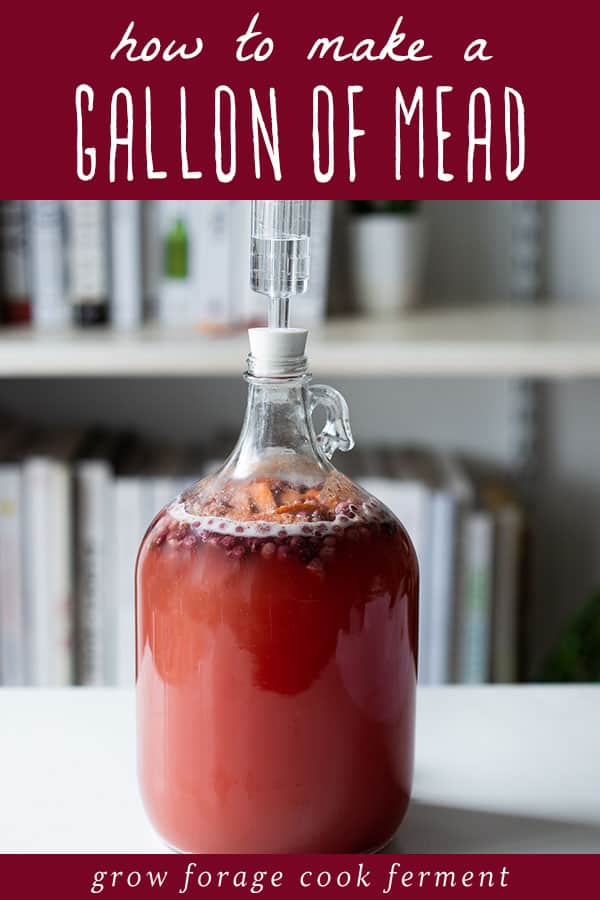
Want to save this post for later?
Simple Mead Making eBook
Want to learn more about making mead? I have a Simple Mead Making for Beginners eBook just for you!
It has ingredient and equipment checklists, detailed instructions for brewing and bottling your mead, and simple mead recipe ideas! Be sure to check it out if you’re new to the mead making process and want a step by step guide.
One Gallon Mead Recipe
Here is my simple method for making one gallon of mead!
What is Mead?
Mead is a fermented alcoholic beverage that is traditionally made with just honey and water, and maybe some yeast (wild yeast is often used).
Whenever you add fruit to mead it’s technically called a melomel rather than mead. I still usually default to calling it mead, though.
You could also use apple cider instead of water and then you’d have what’s called a cyser. If you add herbs and spices or other flavorings it’s called a metheglin.
Mead Equipment and Ingredients
There is some special equipment and ingredients that you will need to make this mead.
Rather than list it all here, I’ve created a page that has links to all of my favorite mead ingredients and equipment: Mead Equipment & Ingredients: Everything You Need to Get Started.
There you will find links to the sanitizer, brewing jugs and buckets, airlocks, yeast, tubing, bottles, and honey and I recommend!
How to Make Mead: One Gallon Mead Recipe
Alright, let’s get started on making this mead!
This is a recipe for one gallon of mead, but I’m always of the mind that if you’re making one you might as well make two.
You can split a package of brewing yeast up between two jugs (one package can make up to 5 gallons of mead).
Sanitize Everything
The first thing to do is sanitize everything that will be used in the brewing process: the jug, airlock, big pot, spoon and funnel.
Simply follow the directions on the sanitizer and don’t throw it out until you’re totally done (just in case your dog licks the funnel or you drop your spoon).
Make the Mead Must
Once everything is sanitized, put about 1/2 gallon of non-chlorinated (filtered) water in a large pot on medium heat. When it’s warm, but not boiling, add the honey and stir until it dissolves.
Using two pounds of honey will make a very “dry” mead (not sweet), while three pounds will create a sweeter mead.
The type of yeast you use will also affect how dry or sweet the mead is.
Turn the heat off. It may be a little foamy, but that’s ok.
In the meantime, put the berries (or any fruit of your liking), orange slices (skin and all), and raisins into the one gallon jug.
Raisins are added as a natural nutrient for the yeast. You will not notice any flavor from them in the finished mead.
Then, using the funnel, carefully pour the honey water mixture (technically called “must”) into the jug.
Top off the jug with cool non-chlorinated (filtered) water, leaving at least 2 inches of head space on top.
Then put the lid on the jug and gently mix everything around a bit. If you bought a jug that came with an airlock it may not come with a lid, so you’ll have to find a lid that fits or improvise a bit here. A solid cork (without a hole for the airlock) would work.
Pitch the Yeast
The next step is to add the yeast, but you need to make sure that it isn’t too hot, which will make your yeast inactive. It should feel lukewarm, no more than 90° F (32° C). I recommend using a thermometer before adding the yeast to be sure.
Once it is less then 90° F you can pitch the yeast into the jug.
You don’t need to use the whole package of yeast for one gallon, 1/2 package is enough (it doesn’t have to be an exact measurement). Store the opened yeast package with the remaining yeast in an airtight zip top bag in the refrigerator for later use.
Now the fermentation fun can begin!
Once you’ve pitched the yeast, put the lid back on tightly and this time you’re really going to shake it up for several minutes.
It’s a good workout for your arm muscles, so you can skip the gym on days when you make mead!
Add the Airlock
Put a little water in the airlock to the line, then put the rubber stopper into the jug.
In a few hours you should start to see bubbles forming in the jug and in the airlock.
After several hours or overnight, you may see a lot of bubbles rising up the neck of the bottle! The whole top might get a little foamy at first, but things will settle down.
Don’t worry if the bubbles rise up into the airlock for the first couple of days, that just means that you have a very active (and happy) batch of mead! You can periodically remove the airlock to rinse it out, then replace it back into the jug.
I love watching all the little bubbles! Fermentation is so cool.
Set Aside to Ferment
Keep the jug in a cool (not cold) dark place out of direct sunlight to ferment.
Mead can take longer to ferment than hard cider or beer, depending on the ambient temperature it will take anywhere from 3-6 weeks.
I usually give it 5-6 weeks before bottling to be on the safe side, as you don’t want any broken bottle explosions! I’ve definitely had some very champagne like mead before.
You want to wait until you don’t see any bubbles in the jug and your airlock is still before bottling.
Bottle the Mead
Bottling one or two gallons of mead is the same process as bottling hard cider. Follow my tutorial there to get a detailed process.
You may want to wait a while to drink your mead as it definitely gets better with age.
I often drink it “green” (young) as I enjoy it either way. It is fun to save a couple of bottles for several months, or even a year, just to see how the taste changes with age.
More Mead Recipes
Now that I’ve shown you how to make this simple one gallon of mead recipe, chances are you will want to make more soon!
I have written posts on How to Make 5 Gallons of Mead and How to Bottle 5 Gallons of Mead if you want to try making a larger batch.
I have one gallon mead recipes for Wildflower Mead, Dandelion Mead, Blackberry Mead, Elderberry Mead, Elderflower Sparkling Mead, and Maple Orange Mead that are all delicious and follow this same basic mead recipe.
See my post on 15 Easy Mead Recipes for Beginners for even more!
If hard cider is your thing, see my posts on brewing hard cider and making hard cider with wild yeast.
Be sure to check out my Simple Mead Making: A Beginner’s Guide to One Gallon Batches eBook for more detailed information on brewing, bottling, and recipe ideas!
Cheers and happy mead making!
Simple One Gallon Mead Recipe
Equipment
Ingredients
- water non-chlorinated or filtered
- 2-3 pounds honey depending on how sweet you want to end product to be.
- berries or fruit of any kind fresh or frozen, about a cup
- 1 orange
- 10 raisins
- 1/2 package champagne yeast or other wine yeast
Instructions
- Sanitize everything that will be used in the brewing process.
- Heat about 1/2 gallon of non chlorinated water in the pot on medium heat. Once it's warm, but not boiling, add the honey and stir it so it all dissolves. Turn off the heat.
- Put the berries or other fruit, orange slices (skin and all), and raisins into the one gallon jug.
- Use the funnel and carefully pour the honey water mixture into the jug.
- Top off the jug with cold (preferably filtered) water, leaving at least 2 inches of head space on top. Put the lid on the jug and gently mix everything around a bit.
- Make sure that the temperature of the must is below 90°F, then add 1/2 packet of champagne yeast. Put the lid back on tightly and this time shake the jug for a minute or two to distribute the yeast.
- Put a little water in the airlock to the line, then put the rubber stopper end into the jug. Put the jug in a dark place. It should start bubbling within 12-24 hours.
- After about 4-6 weeks of fermenting, once all bubbles have stopped rising in the jug and airlock, the mead can be bottled and aged.
Notes
- Please see my Mead Equipment and Ingredients page for a detailed list of what you need to get started.
- Use my tutorial on Bottling Hard Cider to bottle the mead - the process is the same. The flavor of homemade mead will improve after bottling and aging.
- My Simple Mead Making eBook is a helpful resource if you are just getting started with making your own mead.

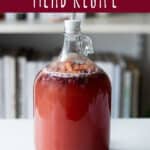
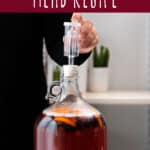

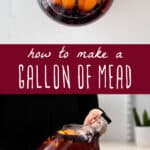
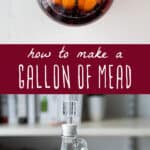
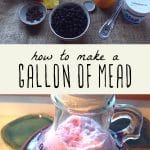
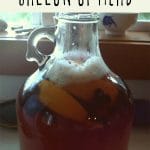
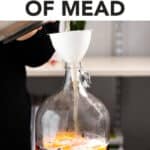
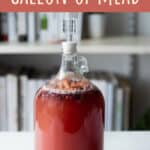
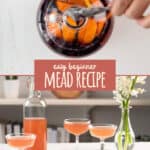


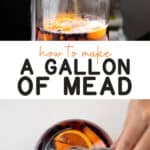

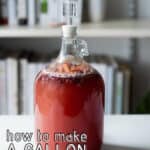
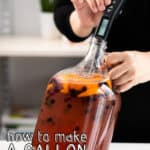
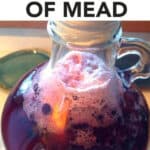
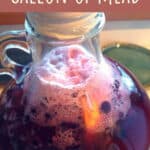
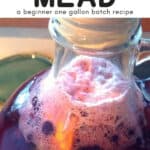
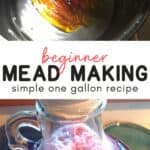
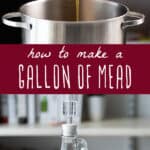
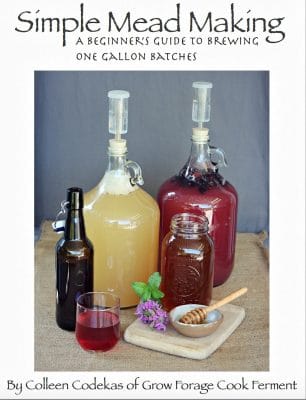


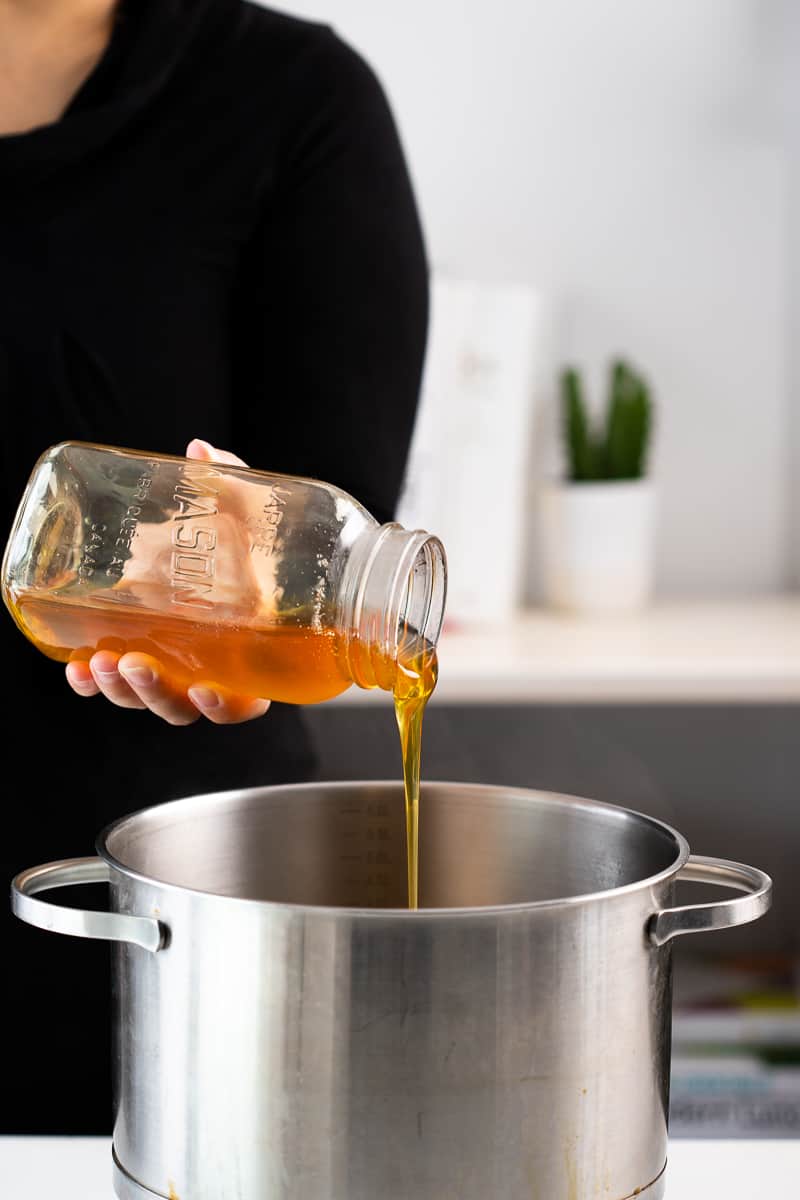
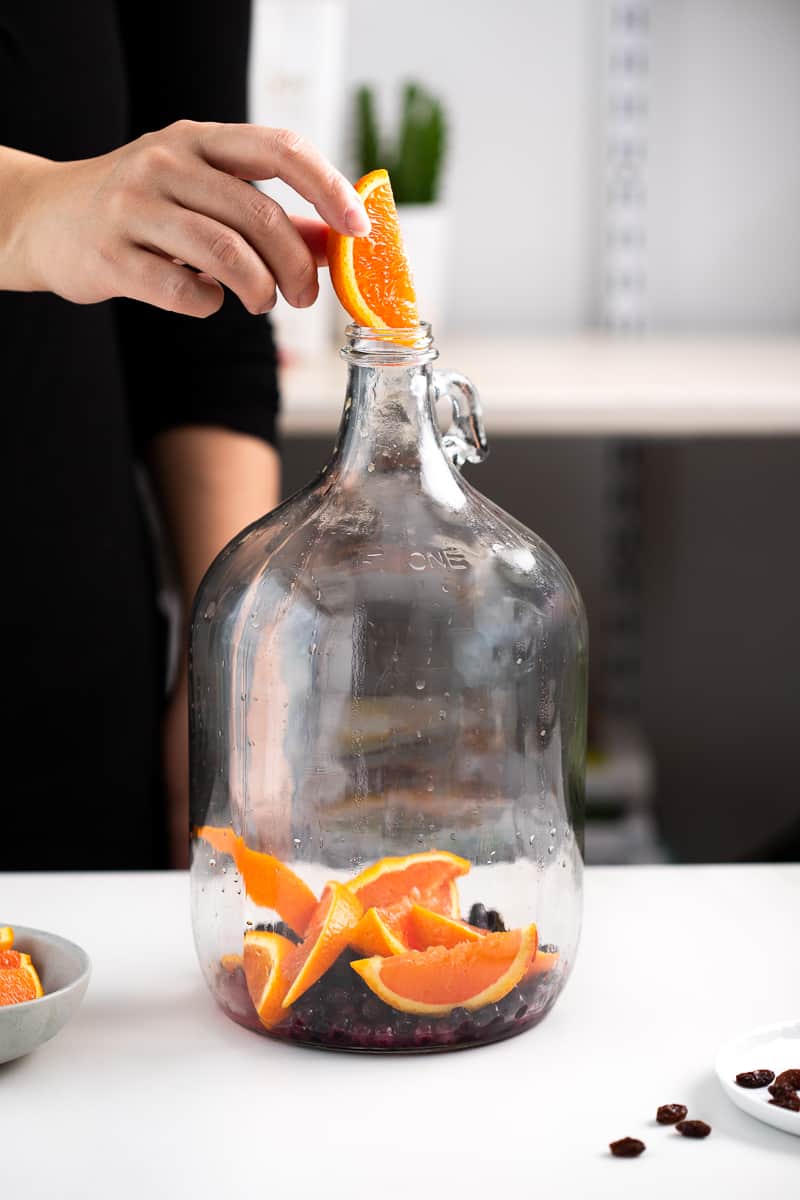
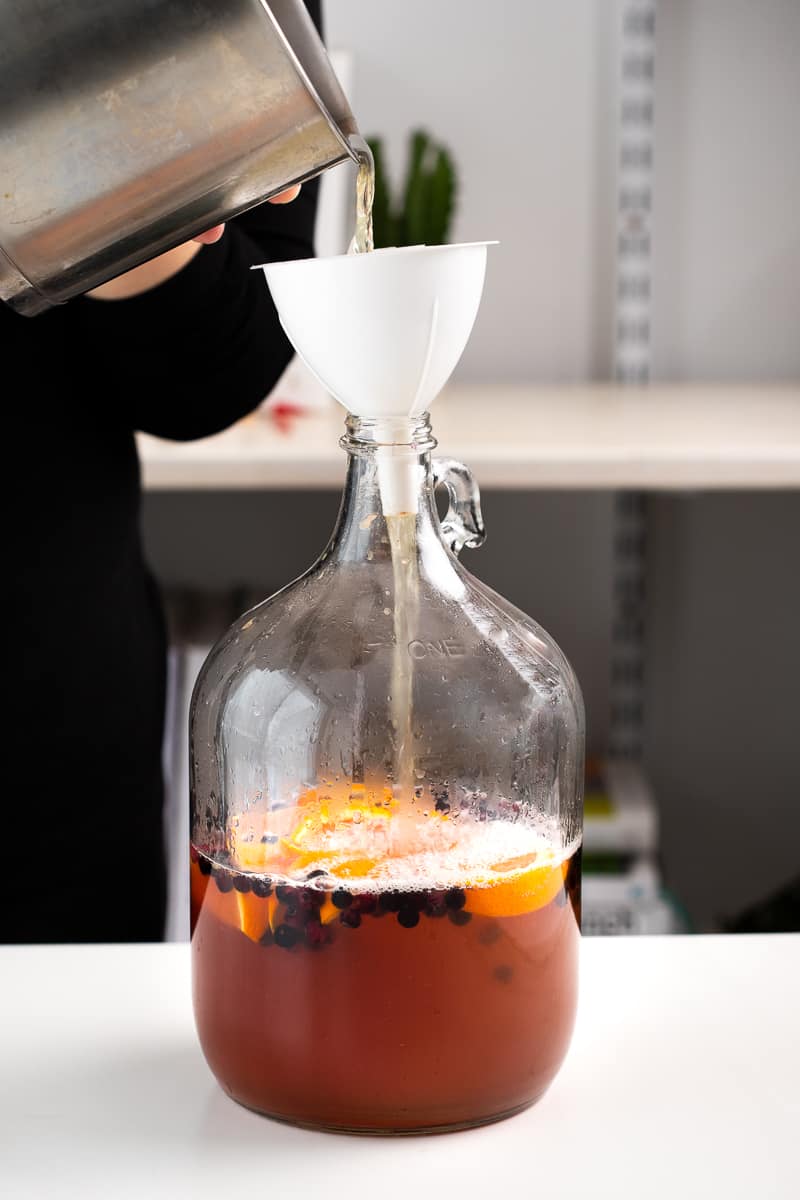
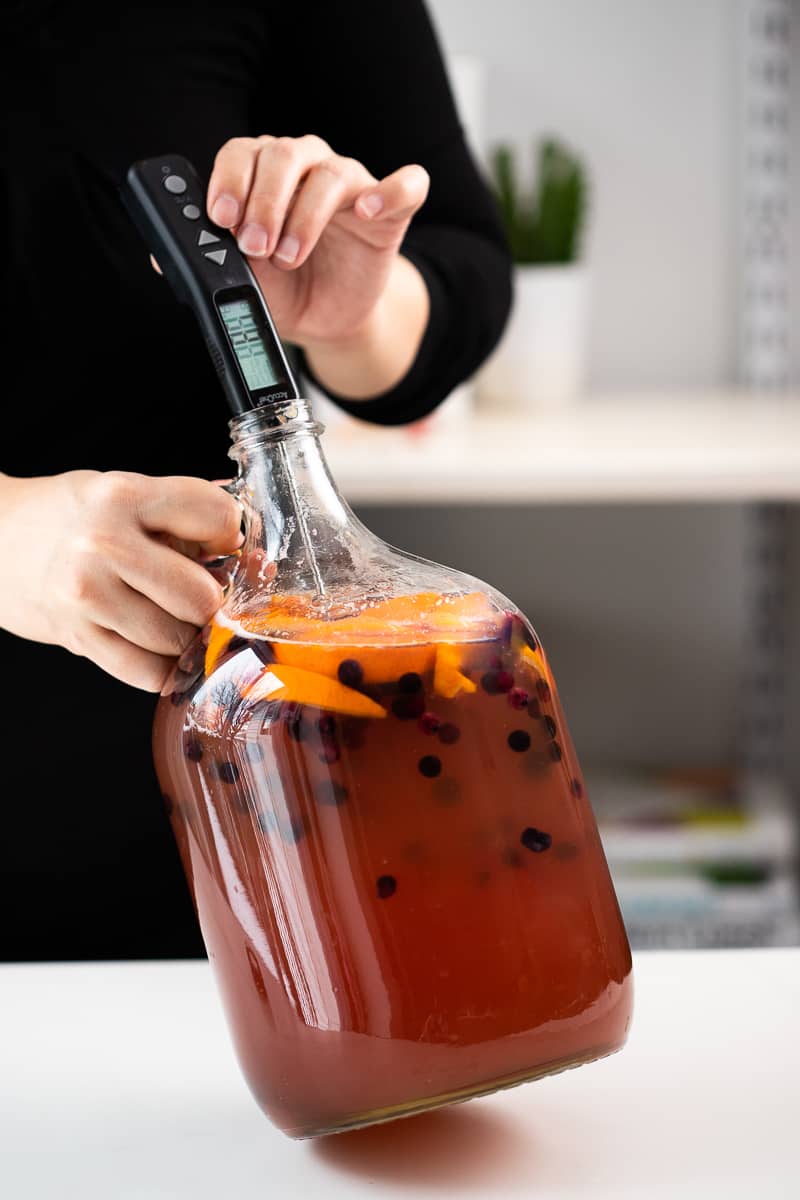
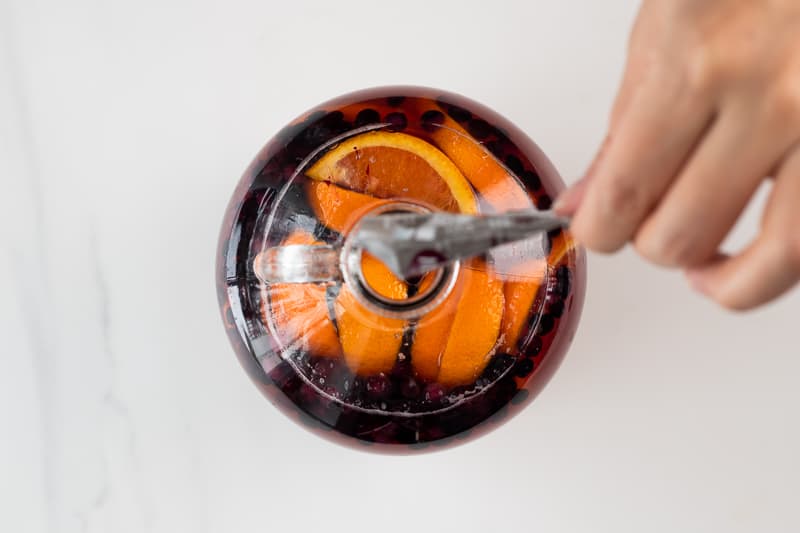

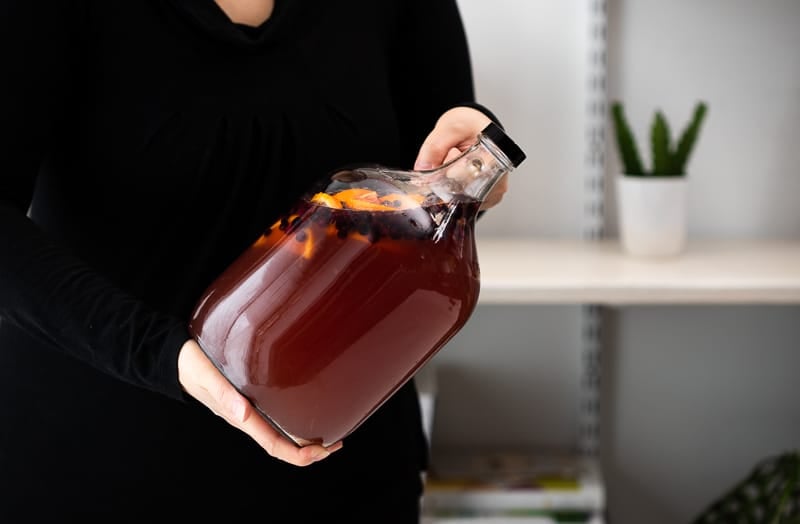
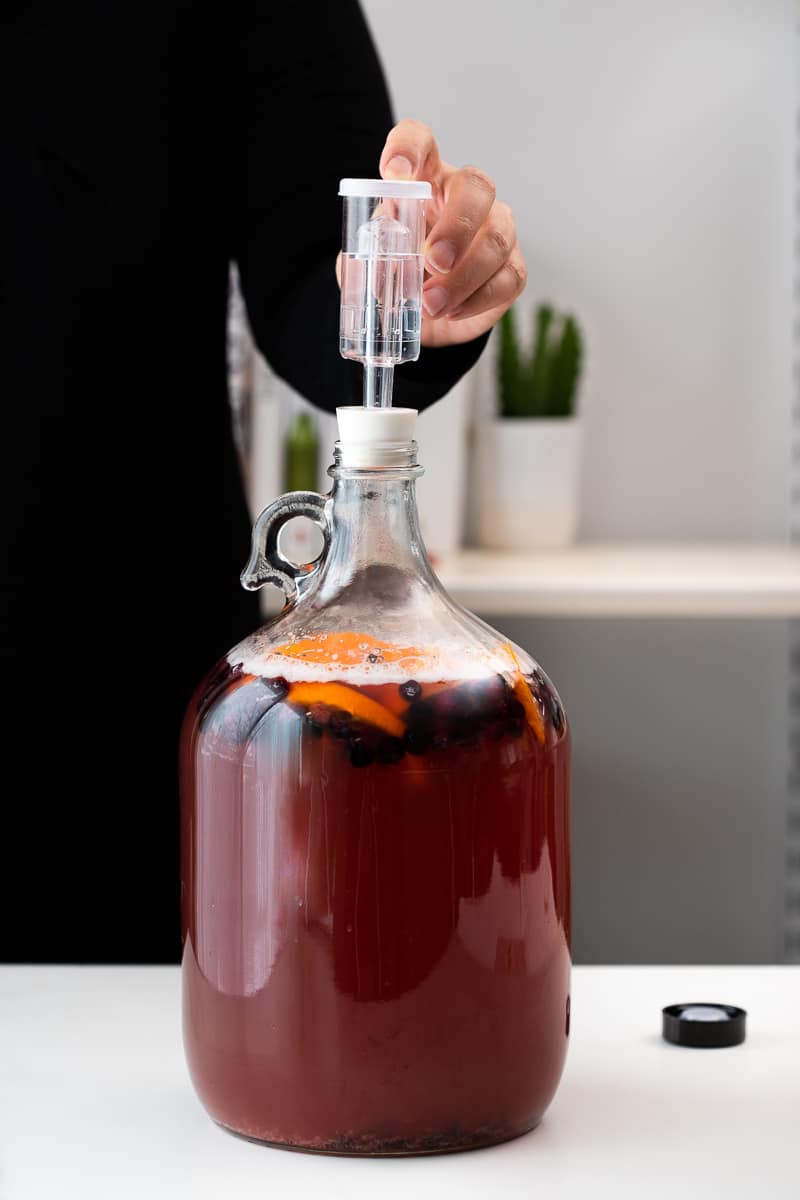
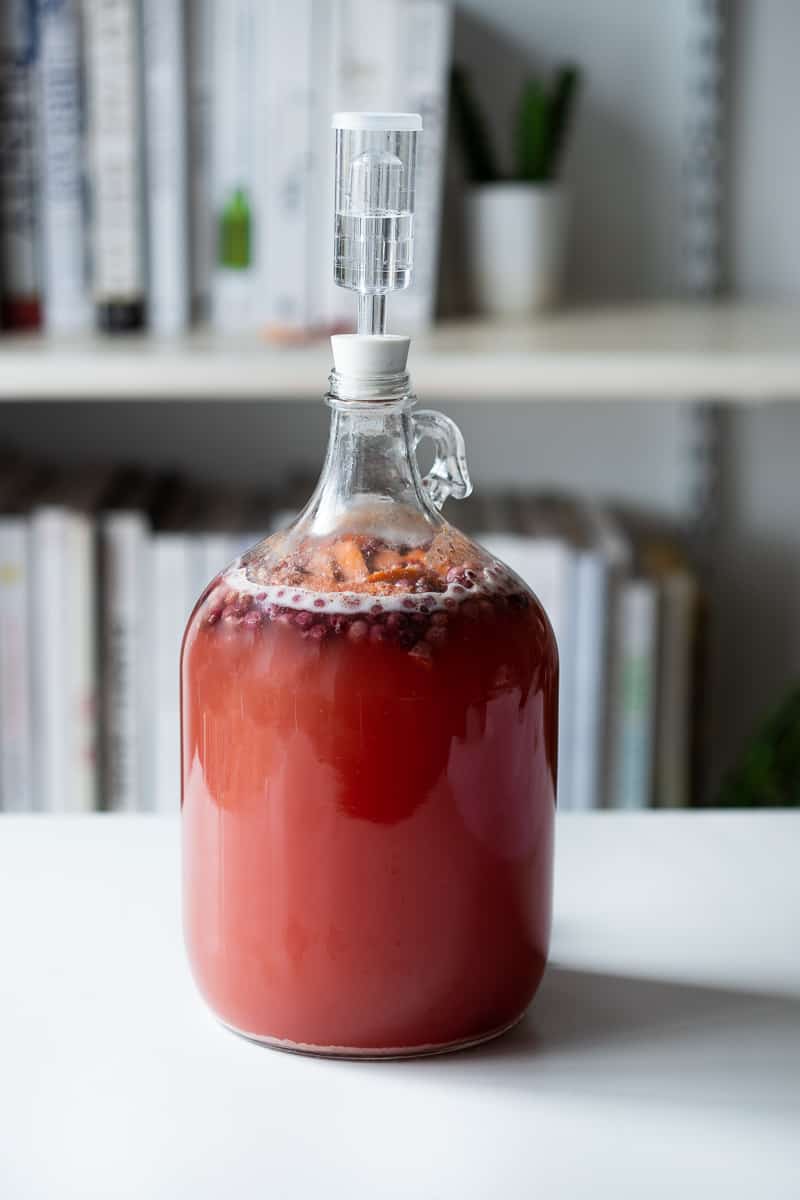



I start my first gallon of mead a week ago it was working and bubbly now a week later is acts like it’s not doing anything is this normal
Yes, it’s normal for fermentation settle down. If there is no more bubbles coming up through the airlock, you can proceed to the next step, bottling.
Hello Colleen.
Just wondering if you can use honey that has already started to ferment? It’s at the stage where is smells of alcohol. The honey doesn’t quite taste right but not bad and isn’t as sweet as normal. Will this affect the final outcome? Should I just pour it out for the animals/insects to enjoy?
Personally, I wouldn’t use it. Honey doesn’t ferment on its own, so water or another liquid must have got to it somehow and this could cause an off-putting flavor to your mead or worse, cause mold.
Your recipe calls for 2-3 pounds of honey, How many liquid ounces of honey is that?
There’s 16 oz. in a pound so 32-48 oz.
Thanks, the reason I asked, is because when I’ve made beer, the corn sugar that fills an 8 ounce measuring cup , only weighs 6 oz.
BEWARE. 16oz by weight does NOT equal 16oz by volume.
16 FLUID OZ of honey = 1.5lbs
2-3lbs of honey = 24-32 fluid oz (and also 32-48oz by weight)
http://convert-to.com/246/honey-amounts-converter.html
If I cannot eat oranges and I’m making plum wine, what fruit will add the yeast nutrient, or will the plums suffice? Thank you
The orange is just to balance the flavor of the mead. It’s the raisins that act a yeast nutrient, so feel free to not use any, if you prefer.
Oh thank you so much!!!!
This recipe looks fantastic—can’t wait to try my hand at making my own batch of mead with a fruity twist!
Great recipe! We’ve done one Demi-John of Blackberry Mead as per the recipe, one of Pear Mead. The pear mead mixture tasted stunning :)
2.5g of wine yeast used in each DJ, 250g of fruit in each and then 1,125g of honey. Plenty of sugar for that yeast to eat!
What’s the expected ABV% for this recipe?
Hi there. I am not sure. I didn’t use a hydrometer.
When making Dandelion wine, do I just add the boiled petals instead of the fruit?
Hi Patty. I don’t have a recipe on my blog for dandelion wine, did you mean dandelion mead? I first make a dandelion tea before adding the honey and then add that mixture to the jug.
Great recipe! I just used it to start my fourth batch of mead–blueberry and blood orange this time. You’re right that fermentation is cool. I can’t wait to see the dancing bubbles. Thanks so much.
I just started my first batch, so I am a ways from bottling still. Once bottled, how long should I age it?
You can age it however long as you like! 6 months or a year is pretty standard.
Hi,I wanted to try making a gallon of the mead. Do I have to bottle in individual bottles? Or can I just leave it in the gallon jug and drink it as I want to a little at a time?
I haven’t done it, but if I’ve read you can. You’ll need to seal the bottle in some way.
Oxygen is the enemy of wine. If you leave the wine in the gallon jug/bottle that is 1/2 full, it will go bad. I would buy a boxed (cheap) wine and use it for cooking then fill the bag with your batch of mead/wine. That way when the bag goes part empty, it will not be exposed to air. Happy wine making…
Thank you for your recipe. I just bottled my first batch of plum mead. It tastes great. I started a second one with cranberries. My question I have is can I use pineapple to make mead and is it the same process?
Absolutely. Enjoy!
Hi,I wanted to try making a gallon of the mead. Do I have to bottle in individual bottles? Or can I just leave it in the gallon jug and drink it as I want to a little at a time?
Thanks for the recipe. I want to try it in the next few days.
The recipe says to use Champagne yeast, but earlier in the article it mentions brewers yeast. Does the type of yeast make a big difference? If I only have brewers yeast, would it still make for good mead?
Yes, types of yeast can dramatically change the flavor profile. I usually use champagne yeast or D47 (usually used for white wines) for mead, but any yeast will ferment honey. I would read about the characteristics of the brewers yeast you have and whether or not they align with the flavor profile you’d like your mead to have.
How do you handle a cloudy mead? Mine is very slow an almost to the 4 week mark.
Just wanted to let you know that I made this recipe last year and it came out beautifully. I just finished the last bottle a few days ago, and I’m going to start a new batch shortly. Thank you!
Wonderful. Enjoy!
Hi! I’m very interested in making Meade but do not like sweet- this recipe sounds great but curious know the level of sweet?
Thank you !
It will be sweet. You can use less honey, 2 pounds or so and it’ll be less sweet.
Thanks for your recipe for making mead. Great suggestions—and you make it very straight forward for 1st timers.
Two items to note:
1st ‘Brewers’ yeast will cause a fermentation reaction, but will most definitely not give you the flavor you are hoping for. Stick with yeast strains most identified with fermenting wines, like the Champagne you mentioned or Cotes du Rhone.
2nd Adding more honey to the initial must will NOT make your final product more sweet. Yeast+nutrient+sugar=alcohol. Yeast will consume ALL the sugar it can (until 12-15% ABV) leaving the mead dry unless you physically interrupt the process. Added more honey will make a higher alcohol mead, not a sweeter one. To sweeten your finished product (as with hard cider) you must ‘back’ sweeten it post-ferment, which may also add carbonation depending on how you bottle/keg. (Beware exploding bottles!) Or flash pasturize (heat) to kill the yeast before back sweetening….
Plant Saps instead of honey? Like molasses or maple syrup?
People use maple syrup and I’m sure you could use others, but I haven’t tried them myself.
Hey – can the bottled mead be kept in a cupboard or does it need to be kept in the fridge?
Thanks!
They need to be kept in a cool, dark place, like a basement or unheated garage. Refrigerators are too cold.
I have made the mead and bubbling is almost stopped, so I am getting ready to bottle it. Do I need to burp the bottles or can I just store them?
As long as it’s no longer fermenting and you racked the mead off of the dead yeast at the bottom of your vessel, the bottles won’t need to be burped.
I see a lot of recipes that call for a yeast nutrient, does this recipe not require one because of all of the fruit, or would I still need to add nutrient?
Hi Samantha. This recipe relies on the raisins and orange for yeast nutrients.
Hi, I made a gallon of mead, according to your recipe. I made it on 4th Nov, I check it every other day, but the fermentation is very low, ie bubbles every 5 to 8 seconds, not going crazy like it should. It’s in the dark and untouched, have I done something wrong ?
Hi, any idea the alcohol percent?
I didn’t the APV of this recipe.
Do I leave the fruit in the jug until bottling time in 4-6 weeks?
Yes, I do.
Does it always take 4-6 weeks?
Roughly, yes. It’s done fermenting when there are no bubbles coming up through the airlock.
Do u do a secondary fermentation?
It’s my first time making meas. I made your recipe. It’s day 6. I hear a lot of people talking about secondary and just wanted to see if u do that or back sweeten?
I don’t, but you certainly can.
can you use store bought juice to dd flavor to the mead?
As long as there are no preservatives.
Can you use frozen fruit? I am hoping to make a blueberry/raspberry mixture and I have a lot of these in the freezer. Would you recommend thawing berries and then adding it + the juice? Or draining the berries first?
Yes, you can use frozen berries. I like to add the berries and the juice to the jug.
Thank you! I will try this in the next few weeks. I recently made a “normal” batch and I like the fruity meads better so I am excited to to try this one!
Hi, I drank a lot of mead at Viking and Celtic festivals and I wanted to try it, but I don’t like putting fruit and spices in it, I like it plain… In this case, what should I do?
thank you for your recipe! i have just siphoned my first batch into 2 half gallon jugs after 8 weeks of fermenting. should i add an airlock, or just put in the screw top and let it age…i just don’t want it to explode! thank you
As long as you siphoned all of the liquid away from the sediment at the bottom of the jug, it shouldn’t continue to ferment. Here are my instructions for bottling.